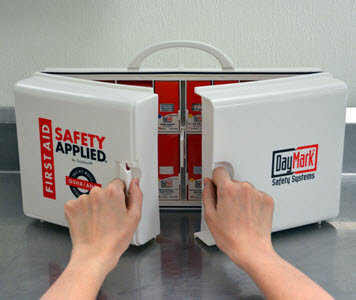First Aid Kits: What We Need to Know
Posted on 20th Oct 2017

Building managers as well as cleaning contractors are legally responsible for ensuring first aid supplies are available for their staff.*
This is just one of many things managers and contractors may not be aware of regarding first aid kits, according to Duane Carey, a thirty-year cleaning industry veteran now heading DayMark Safety Systems’ entry into the professional cleaning industry.
Other key considerations Carey says we should be aware of are the following:
- The first step in selecting a first aid kit is to analyze past injuries in the workplace. In most cases, a standard but well-stocked first aid kit will address most situations.
- Many states have their own health and safety regulations that encompass first aid kits. Find them here at http://tinyurl.com/ya6hhn42
- The American National Standards Institute (ANSI) has recently updated first aid kit requirements into two classes, based on the contents and the number of first aid supplies included in the kits. Class A kits are designed for the common workplace injuries; Class B kits deal with more complex injuries or high-risk environments.
- If first aid instructions are provided with the kit, make sure they are bi- or multilingual.
- In industrial locations, managers and service providers should have a worksite safety assessment. This helps identify safety deficiencies, meet regulatory requirements, and determine what types of first aid kits are needed.
- In food service locations, select a kit that has highly visible blue colored fabric bandages. This helps ensure food safety, allowing food handlers to easily see if the bandage has fallen off.
- Keep all first aid kits in easily accessible areas; there may also be regulatory requirements as to where the first aid kits are stored.
- Managers and supervisors should monitor kits regularly to ensure enough supplies are available. When ordering, some manufacturers provide “bundled refill systems,” combining items frequently used in one order to ensure many commonly used supplies never run out.
“Managers and [cleaning] contractors must also create a culture of safety in the workplace,” says Carey. “While there are many steps in the process, it all starts with having the right first aid kits available when needed.”
For more information on safety and first aid kits, contact a DayMark Safety Systems representative.
For more information on meeting ANSI standards with proper first aid equipment, contact a DayMark representative at 1-866-517-0490.
* OSHA's standard 29 CFR 1910.151 (b)


